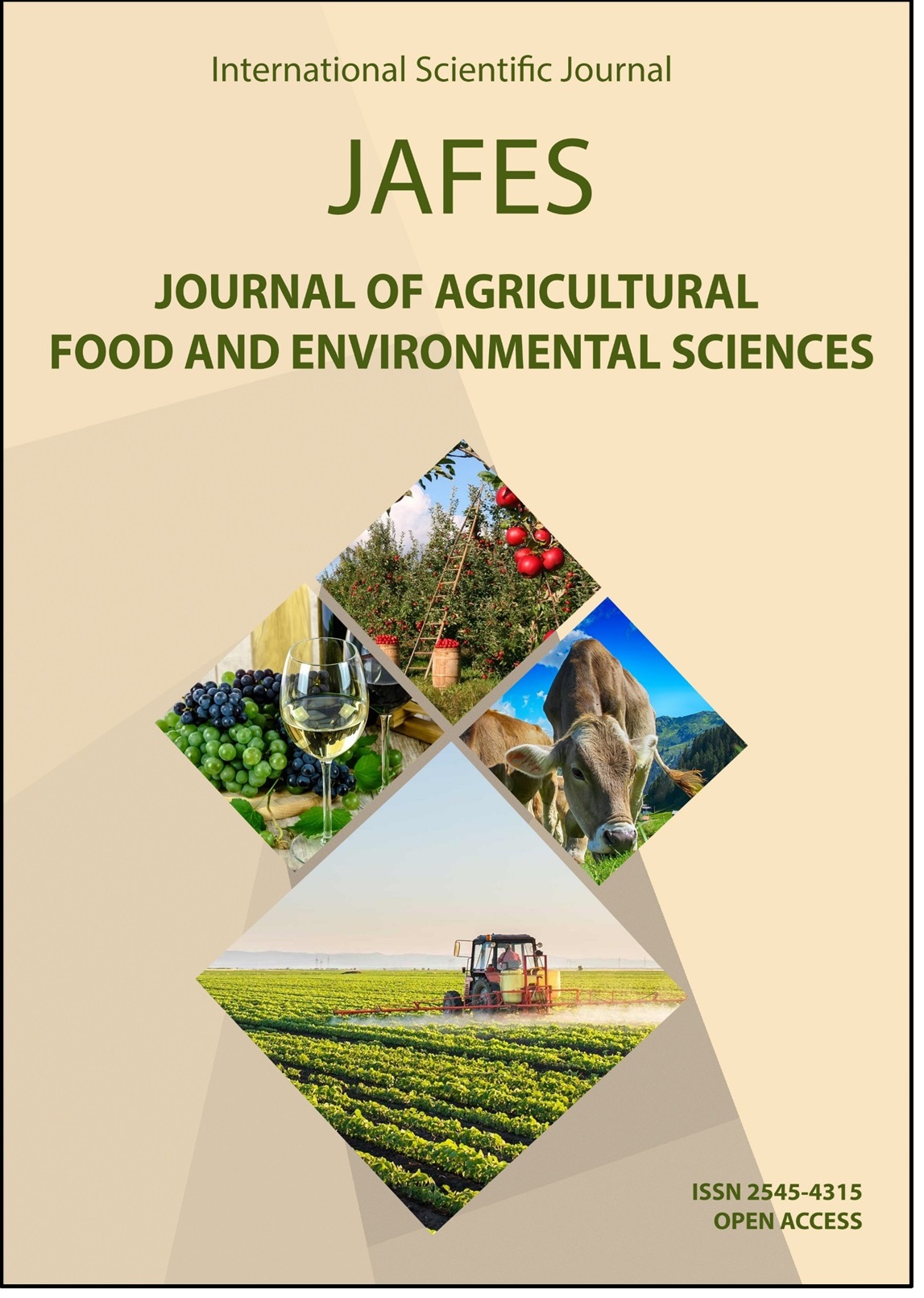QSAR MODELING OF pKа VALUES OF SULFONYLUREA HERBICIDES
Клучни зборови:
herbicides, sulfonylureas, SwissADME descriptors, QSAR modelsАпстракт
Sulfonylureas are herbicides primarily used for control of weeds in early growth stages of cultivations. Structurally sulfonylureas contain a sulfonyl group with sulphur atom bonded to nitrogen atom of an ureylene group. According side chains there are pyrimidinyl-sulfonylureas and the triazinyl-sulfonylureas. Swiss ADME descriptors have been used to develop QSAR models for predicting the pKa values of selected 27 sulfonlyurea herbicides: 17 pyrimidinyl- and 10 triazinyl-sulfonylurea herbicides. Variable selection methods including stepwise, forward, and best model were employed. Two different approaches were performed to develop a predictive QSAR model: a set with all selected herbicides and a divided set according structure (pyrimidinyl/ triazinyl). QSAR models were analyzed using following statistical parameters: coefficient of correlation, adjusted coefficient of correlation, mean squared error, root mean square error, and Fischer test. Models with four descriptors in both sets of herbicides were statistically better, based on the values of these parameters.
Референци
Bempelou, E., Kappatos, P., & Liapis, K. (2019). Determination of Eight Sulfonylurea Herbicide Residues by LC/MS/MS Using a Sample Separation Technique with Ethyl Acetate. J. AOAC Int., 102, 239-245.
CDC - Centers for Disease Control and Prevention. Biomonitoring Summary -Substituted Urea Herbicides (2023, March). https://www.cdc.gov/biomonitoring/
Chedik, L., Mias - Lucquin, D., Bruyere, A., & Fardel, O. (2017). In Silico Prediction for Intestinal Absorption and Brain Penetration of Chemical Pesticides in Humans. Int. J. Environ. Res. Public Health, 14, 708.
Daina, A., Michielin, O., & Zoete, V. (2017). SwissADME: A free web tool to evaluate pharmacokinetics, drug-likeness and medicinal chemistry friendliness of small molecules. Sci. Rep., 7, 42717.
Daina, A., & Zoete, V. (2016). BOILED-Egg to predict gastrointestinal absorption and brain penetration of small molecules. Chem. Med. Chem., 11, 1117-1121.
Devlin, D., Barden, C., Barnes, P., Bernards, M., Franti, T., Milner, M., Regassa, T., Shea, P., & Wortmann, C. (2008). Pesticide Management for Water Quality Protection in the Midwest, Regional Water Coordination Initiative, Kansas State University.
İslamoğlu, F., & Hacifazlioğlu, E. (2022). Investigation of the Usability of Some Triazole Derivative Compounds as Drug Active Ingredients by ADME and Molecular Docking Properties. Moroccan Journal of Chemistry, 10, 861-880.
Liu, C., Zhang, T., Yang, X., Wang, L., Long, Y., Hasi, A., Pei, X. (2023). A Lu ALS Mutation with High Sulfonylurea Herbicide Resistance in Linum usitatissimum L. Int. J. Mol. Sci., 24, 2820.
Losito, I., Amorisco, A., Carbonara, T., Lofiego, S., & Palmisano, F. (2006). Simultaneous determination of phenyl- and sulfonyl-urea herbicides in river water at sub-parts-per-billion level by on-line preconcentration and liquid chromatography–tandem mass spectrometry. Anal. Chim. Acta, 575, 89-96.
Marchand, P. A. (2023). EU Chemical Plant Protection Products in 2023: Current State and Perspectives. Agrochemicals, 2, 106-117.
Mostafalou, S., & Abdollahi, M. (2017). Pesticides: An update of human exposure and toxicity. Arch. Toxicol., 91, 549–599.
Pathak, V. M., Verma, V. K., Rawat, B. S., Kaur, B., Babu, N., Sharma, A., Dewali, S., Yadav, M., Kumari, R., Singh, S., Mohapatra, A., Pandey, V., Rana, N., & Cunill, J. M. (2022). Current status of pesticide effects on environment, human health and it’s eco-friendly management as bioremediation: A comprehensive review. Front. Microbiol., 13, 962619.
Pereira, V. J., Cunha, J. P. A. R., Morais, T. P., Ribeiro - Oliveira, J. P., & Morais, J. B. (2016). Physical-chemical properties of pesticides: concepts, applications, and interactions with the environment. Bioscience Journal, 32, 627-641.
PPDB: Pesticide Properties DataBase (2023, March) Agriculture and Environment Research Unit, School of Life & Medical Sciences, University of Hertfordshire, College Lane, Hatfield, Hertfordshire, UK. http://sitem.herts.ac.uk/aeru/ppdb
PubChem - Open chemistry database at the National Institutes of Health (2023, March). https://pubchem.ncbi.nlm.nih.gov
Sadeghi, F., Afhami, A., Madrakian, T., & Ghavami, R. (2022). QSAR analysis on a large and diverse set of potent phosphoinositide 3 kinase gamma (PI3Kγ) inhibitors using MLR andANN methods. Scientifc Reports, 12, 6090.
Sjogren, E., Abrahamsson, B., Augustijns, P., Becker, D., Bolger, M. B., Brewster, M., Brouwers, J., Flanagan, T., Harwood, M., Heinen, C., Holm, R., Juretschke, H. P., Kubbinga, M., Lindahl A., Lukacova, V., Münster., U, Neuhoff., S, Nguyen, M. A., Peer, A., Reppas, C., Hodjegan, A. R., Tannergren, C., Weitschies, W., Wilson, C., Zane, P., Lennernäs, H., Langguth, P., & Heinen, C. (2014). In vivo methods for drug absorption - Comparative physiologies, model selection, correlations with in vitro methods (IVIVC), and applications for formulation/API/excipient characterization including food effects. Eur. J. Pharm. Sci., 57, 99–151.
Toropov, A. A., Toropova, A. P., Beeg, M., Gobbi, M., & Salmona, M. (2017). QSAR model for blood-brain barrier permeation. J. Pharmacol. Toxicol. Methods, 88, 7-18.
Wildman S. A., & Crippen, G. M. (1999). Prediction of Physicochemical Parameters by Atomic Contributions. J. Chem. Inf. Comput. Sci., 39(5), 868-873.
XLSTAT – Version 5.03 - Statistical Software for Excel (2014).



